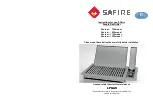
10 — English
OPERATION
STARTING/STOPPING THE SAW
See Figure 10, page 16.
To start the saw:
Depress the lock-off button.
Squeeze the switch trigger.
Always let the blade reach full speed, then guide the saw
into the workpiece.
WARNING:
The blade coming in contact with the workpiece before
it reaches full speed could cause the saw to “kickback”
towards you resulting in serious injury.
To stop the saw: Release the switch trigger.
After you release the switch trigger, allow the blade to come
to a complete stop.
Do not remove the saw from the
workpiece while the blade is moving.
LOCK-OFF BUTTON
See Figure 10, page 16.
The lock-off button reduces the possibility of accidental
starting. The lock-off button is located on the handle above
the switch trigger. The lock-off button must be depressed
before you pull the switch trigger. The lock resets each time
the trigger is released.
NOTE: You can depress the lock-off button from either the
left or right side.
ADJUSTING BLADE DEPTH
See Figure 11, page 16.
Always keep correct blade depth setting. The correct blade
depth setting for all cuts should not exceed 1/4 in. below the
material being cut. More blade depth will increase the chance
of kickback and cause the cut to be rough. For more depth
of cut accuracy, a scale is located on the upper blade guard.
Loosen the depth adjustment knob.
Determine the desired depth of cut.
Locate the depth of cut scale on the back of the upper
blade guard.
Hold the base flat against the workpiece and raise or
lower the saw until the indicator mark on bracket aligns
with the notch on the blade guard.
Tighten the depth adjustment knob securely.
OPERATING THE SAW
See Figures 12 - 14, page 16.
It is important to understand the correct method for operating
the saw. Refer to the figures in this section to learn the correct
and incorrect ways for handling the saw.
WARNING:
To make sawing easier and safer, always maintain proper
control of the saw. Loss of control could cause an
accident resulting in possible serious injury.
DANGER:
When lifting the saw from the workpiece, the blade is
exposed on the underside of the saw until the lower blade
guard closes. Make sure the lower blade guard is closed
before setting the saw down.
To make the best possible cut, follow these helpful hints:
Hold the saw firmly with both hands.
Avoid placing your hand on the workpiece while making
a cut.
Support the workpiece so that the cut (kerf) is always to
your side.
Support the workpiece near the cut.
Clamp the workpiece securely so that the workpiece will
not move during the cut.
Always place the saw on the workpiece that is supported,
not the “cut off” piece.
Place the workpiece with the “good” side down.
Draw a guideline along the desired line of cut before
beginning your cut.
CROSS CUTTING/RIP CUTTING
See Figure 15, page 17.
When making a cross cut or rip cut, align the line of cut with
the outer blade guide notch on the base.
Since blade thicknesses vary, always make a trial cut in scrap
material along a guideline to determine how much, if any,
you must offset the guideline to produce an accurate cut.
NOTE: The distance from the line of cut to the guideline is
the amount you should offset the guide.
Summary of Contents for P205G
Page 31: ...13 NOTES NOTAS...
Page 46: ...14 English NOTES...
Page 59: ...14 Fran ais NOTES...
Page 72: ...14 Espa ol NOTAS...
















































